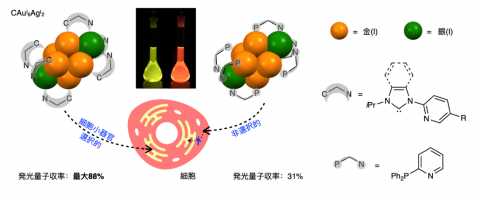Au-Ag nanoclusters showing intense phosphorescence in cells

Luminescent metal nanoclusters are expected to exhibit unique physical properties in the cluster structure depending on the ligand structure, metal type, number of nuclei and arrangement. In this study, carbon-centered gold-silver (CAu6Ag2) clusters with N-heterocyclic carbene (NHC) ligands were designed and synthesized, and it was found that these clusters emit strong phosphorescence in solution, and the contribution of NHC ligands to phosphorescence emission was revealed by theoretical calculation. The luminescence rate constant was calculated by an analysis including spin-orbit interactions, and the quantum yield was discussed in terms of the energy barrier to the minimum energy crossing point. Furthermore, the phosphorescent gold-silver clusters with long luminescence lifetime were used for cellular imaging, which revealed the pathway of uptake into the cell and selective localization to specific organelles, confirming their superior functionality, which is different from the non-selective uptake of conventional phosphine ligands.
N-Heterocyclic Carbene-based C-centered Au(I)-Ag(I) Clusters with Intense Phosphorescence and the Organelle-selective Translocation in Cells
Z. Lei, M. Endo, H. Ube, T. Shiraogawa, P. Zhao, K. Nagata, X.-L. Pei, T. Eguchi, T. Kamachi, M. Ehara, T. Ozawa, M. Shionoya Nature Commun. 13, 4288-1-9 (2022).
N-Heterocyclic Carbene-based C-centered Au(I)-Ag(I) Clusters with Intense Phosphorescence and the Organelle-selective Translocation in Cells
Z. Lei, M. Endo, H. Ube, T. Shiraogawa, P. Zhao, K. Nagata, X.-L. Pei, T. Eguchi, T. Kamachi, M. Ehara, T. Ozawa, M. Shionoya Nature Commun. 13, 4288-1-9 (2022).